Five days in Israel were included in the BT as a pre-cruise excursion. Two of those days included arrival and departure; each of the other three featured an eight-hour tour and some group activities, as well as time on our own. Twenty people in addition to Ted and me signed up for this excursion, and the 22 of us had fun together during those five days.
During our time in Jerusalem, our group of 22 all had the same tour at the same time with the same guide, Amir. The first thing Amir told us was that it is unsafe for us to drink or to brush our teeth with the water in Israel. We were instructed to consume bottled water only.
Most of our touring time was spent outdoors, and Amir always stopped in places where we could stand or sit in the shade while he talked. Can you say “hot”? We can verify that there is a significant temperature difference between full sun and even partial shade, although both were uncomfortably hot in the mid- to upper 90-degree temperatures we experienced. By mid-afternoon, it felt like everywhere we went was uphill and included long flights of stairs to climb.
In Israel, tour guides are required to have a master’s degree that includes studying the country’s culture, history, people, religions, societal norms, etc. An additional certification is also required. Our guide’s name was Amir, and he was with us every day. He was very personable, very knowledgeable, and an excellent storyteller—important skills for good tour guides. I love history and learning, and I found his stories to be fascinating. I knew at the time that I’d never be able to remember all the interesting things he told us, and I was right, but I’ll do my best to describe our time in these historic places.
Jerusalem is also known as the City of David. All Western religions can be found in Jerusalem, and the city is important to each of them in some holy way. For Jews, Christians, and Muslims, it is the place where God dwells, and all three sects have a major temple in Jerusalem. The city is divided into four quarters: Jewish, Christian, Muslim, and Armenian. During our time in Jerusalem, we walked in all four quarters–in the heat, of course. Amir shared the fact that Muslims have 5 commandments, Christians have 10, and Jews have 613 in the Torah.
Our first stop today was Mt. Scopus, which provided a panoramic view of the Ancient City of Jerusalem. The gold dome in the center of the picture is the Dome of the Rock. It is set on the sacred Foundation Stone, upon which Jews believe the world was created. The rock is not visible until visitors are close to it. A cylindrical shaft of light beams on it through an opening in the upper roof. Look to the left of the gold dome and slightly upward to see two gray domes beside each other. (Zooming in on the photo helps.) That is the Church of the Holy Sepulchre, believed to be the place where Jesus Christ was crucified and buried. It is the ending point of the Via Dolorosa (Sorrowful Way or Way of Suffering), the path of the 14 Stations of the Cross.
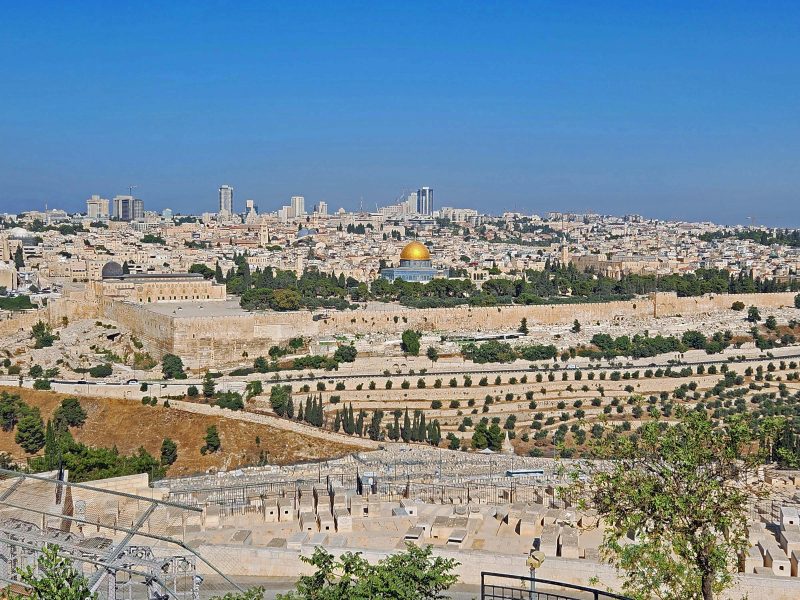
You can see that Jerusalem looks uniformly light in color. That’s because the law requires all buildings in the city to be constructed of Jerusalem stone. Fortunately, there’s a lot of that stone available. The hot, dry climate (average annual rainfall of 20 inches) and the rocky land in this area are not conducive to agriculture as we know it.
In front of the Dome of the Rock, there is a row of trees. Below that, you can see the wall that encloses the Ancient City of Jerusalem. There are three “cities” of Jerusalem: (1) the Ancient City enclosed by the wall in my photo; (2) the Old City, which begins on the foreground side of the wall in my photo; and (3) the New (modern) City, which lies beyond the Old City wall. There are a number of archeological guesses regarding the age of the city of Jerusalem, but the truth is that no one really knows how old it is. Archeological excavations have revealed that Jerusalem has been destroyed and rebuilt at least 17 times.
Keep moving your eyes downward from the Ancient Wall in the photo above to the black line crossing most of the photo from the right. That’s a road. All the light stone in the photo below that road is a cemetery that extends for a great distance. According to our guide and to the best of my memory, there is a belief that, at the end of days, the savior will come first to Jerusalem (where God dwells), and that the first to be resurrected will be those buried closest to the heart of Jerusalem and above the ground. That’s why so many tombs are above ground. It is also important to be buried with your family so that you will be resurrected as a group and will be with your loved ones in the afterlife. The photo below is a close-up of part of that cemetery.

Our second stop of the day was a visit to an ancient excavated reservoir. Winter is the rainy season in Jerusalem and water needs to be collected for year-round use. Water sources include underground springs, some lakes and rivers, and desalinated water from the Mediterranean and Red Seas. I think this reservoir collected water from an underground spring. Can you imagine carefully excavating this a bit at a time to avoid damaging anything that might be in the ground? I definitely don’t have the patience to play in the dirt as an archeologist!
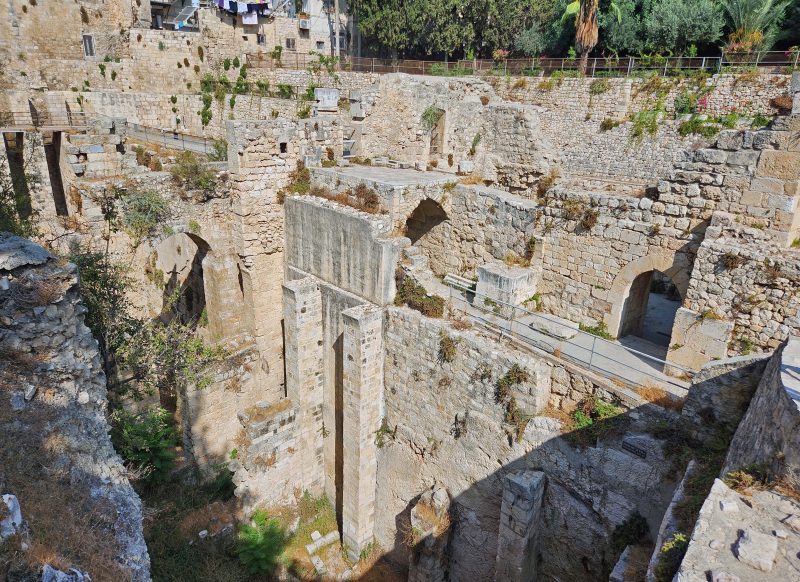

The Church of St. Anne is near (nearly beside) the reservoir. It doesn’t look like much from the outside.
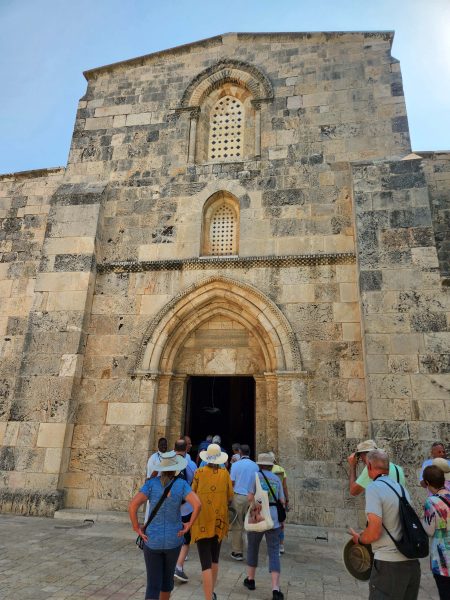
The doors of the church are always open and Amir told us the acoustics are so amazing that people often go inside to sing just because they want to enjoy the acoustics.
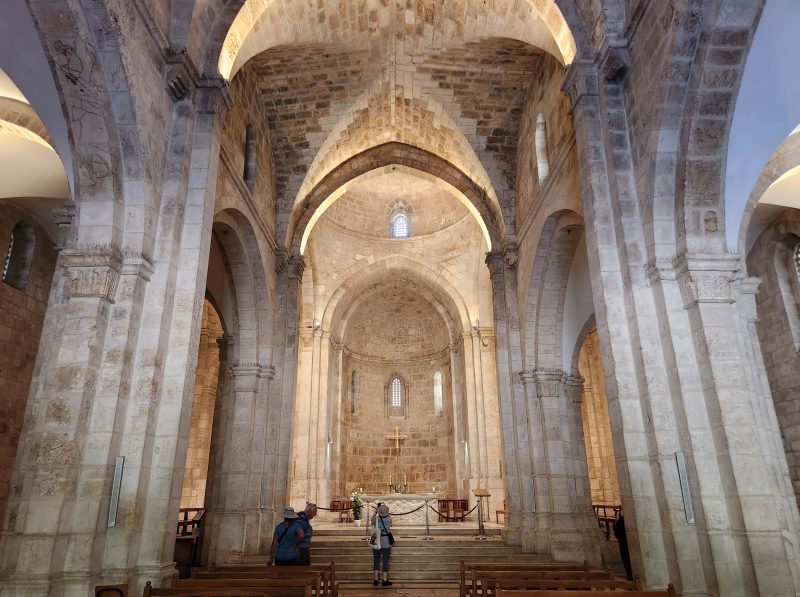
One of our tour stops was the Western Wall on the border of the Jewish and Muslim quarters of the city. It is the last remaining outer wall of the ancient temple, thought to have been started by King Herod the Great, and it is believed to be built on the Holy of Holies, the most sacred site of the Jewish faith. It is also the site at which Muhammed is believed to have tied his winged steed on his Night Journey to Jerusalem before ascending to Paradise.
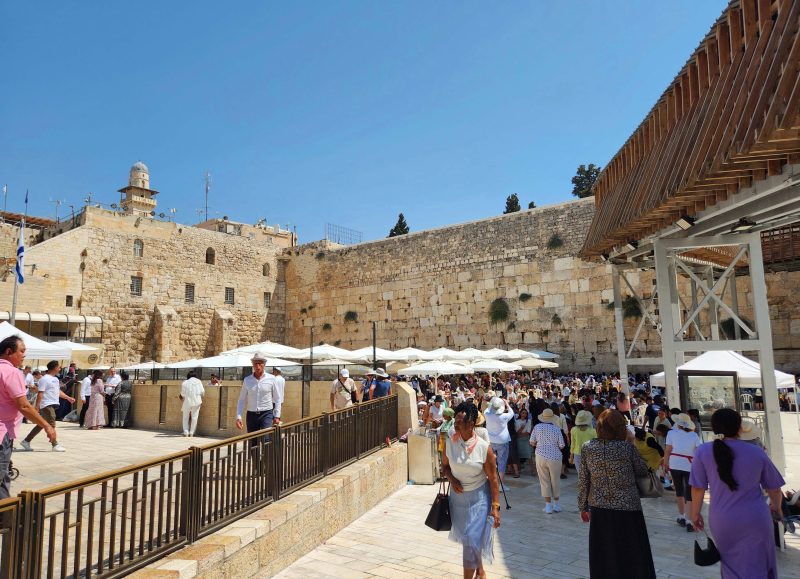
Most of the Wall is reserved for men to pray; a small section is for the women.
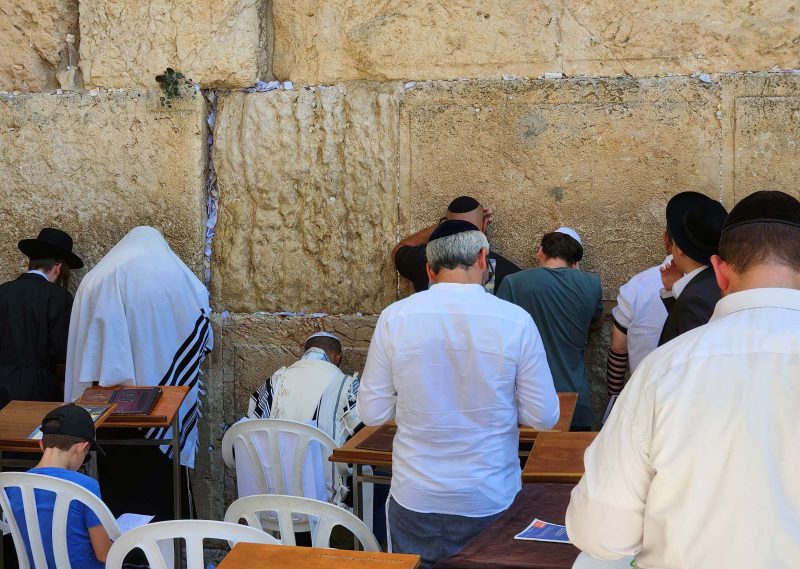
A visit to the Shrine of the Book, the part of the Israel Museum that houses the Dead Sea Scrolls, was another tour stop. The photo below shows the outside of the Shrine. Fountains cool the roof of the underground building to help preserve the documents inside.
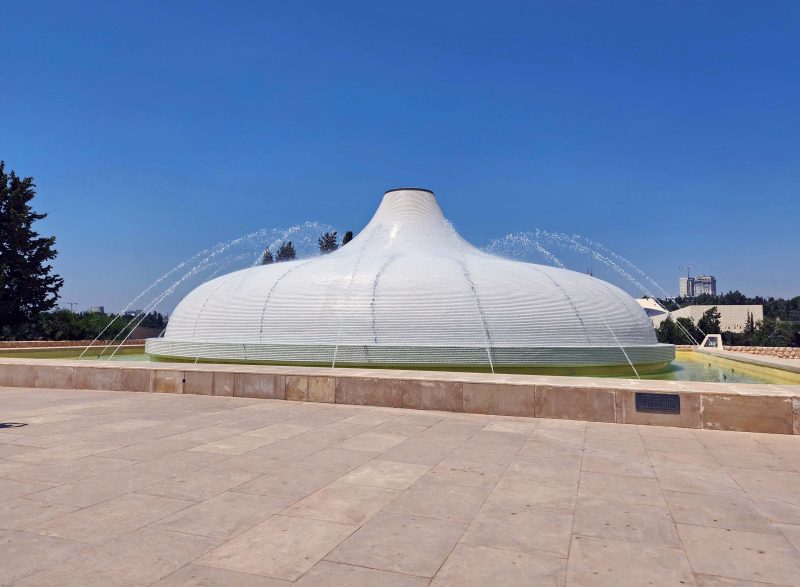
The pieces of the Dead Sea Scrolls that have been found are mounted on the white (lighted) part of the symbolic scroll sculpture in the center of the room. The room is designed so that the Dead Sea Scrolls are elevated (see the stairs). Walking around that center portion of the room, visitors can see many other historic documents. Photos are prohibited inside the room, so I had to take this one from the doorway
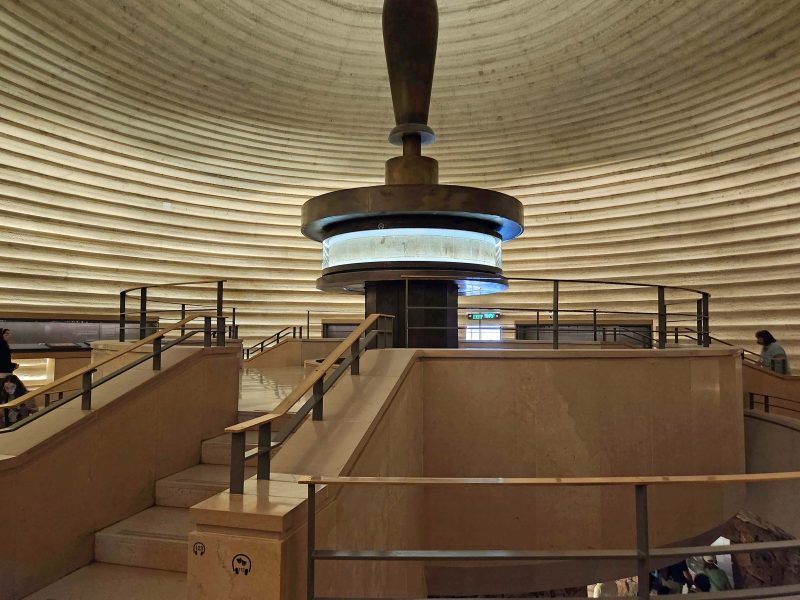
A hospital seems like an odd place to take tourists, but the Ein Kerem Hadassah Hospital deserves a visit. It is a university hospital and the sixth-largest hospital in Israel. The Abell Synagogue on the hospital grounds is unique because it has twelve 11×8-foot windows designed by Marc Chagall. Each window represents one of the twelve tribes of Israel, based on the 49th Chapter of Genesis and the 33rd chapter of Deuteronomy. The brilliant colors in the windows are beautiful.

We had lunch at a city restaurant. Here’s a picture of the neighborhood outside the restaurant. It’s representative of much of the Ancient City.
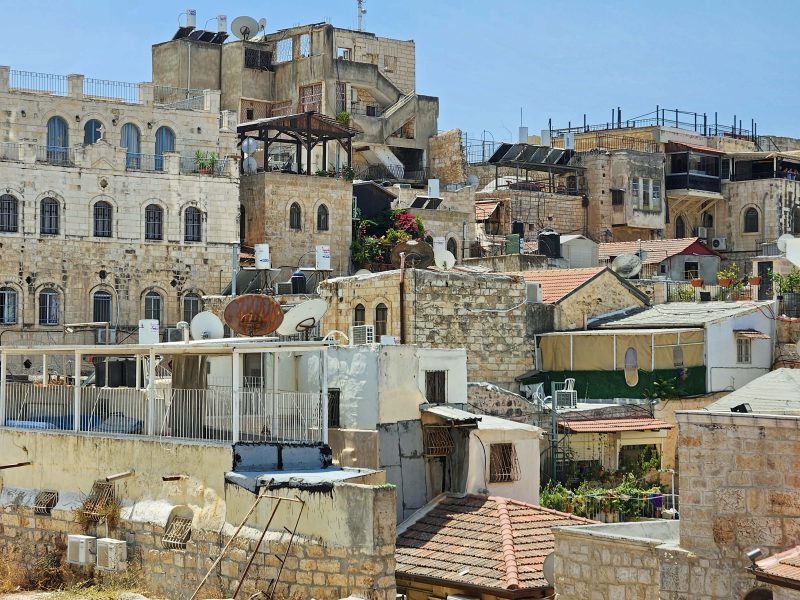
The Old City of Jerusalem had seven gates in its wall, each named for the destination city outside the gate. There are still seven main gates, along with two minor gates that have been opened by archeologists. We visited the Citadel at the Jaffa Gate, pictured below. Leaving the Old City of Jerusalem on the road through this gate took travelers to the city of Jaffa.
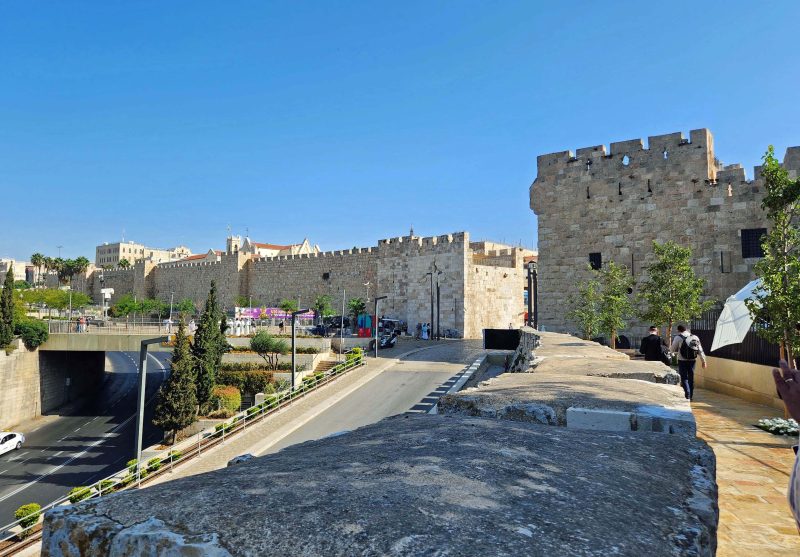
The citadel is the highest point in the city, so it was a logical place to build a fort for protection. The walls of the fort have javelin slots, like the one in the picture below, to defend the city. Amir told us that, during the 1967 Six-Day War, these slots were used again to direct rifle fire at the city. Amir lived in Jerusalem during that time and described hearing gunfire from both directions.
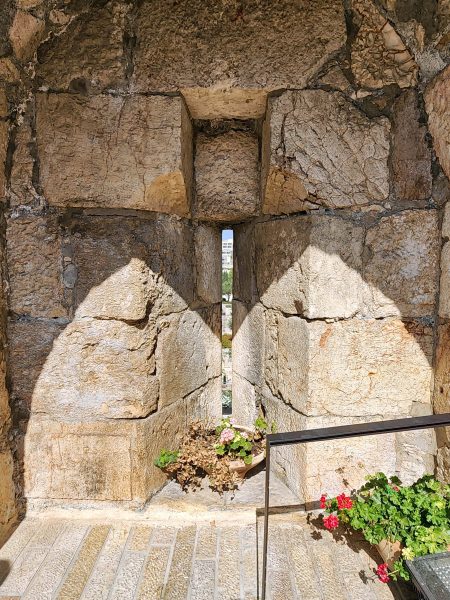
Archeologists are excavating inside the fort walls. The photo below shows some of the excavation, which is still ongoing. The tall tower in the center is the Tower of David.

The Jerusalem Museum is within the fort. I have pictures from inside the museum, but many of the displays were digital slide shows and videos that do not lend themselves to meaningful photographs. The displays were awesome! This is one of the exhibits in the museum. It’s called the cloverleaf map of the world and shows Jerusalem as the center circle on the map. The three “leaves” indicate Europe, Asia, and Africa. In ancient times, they were thought to be the only continents in the world. The man in the photo is our guide, Amir, and he is confidently standing on plexiglass above a 30-foot-deep void.
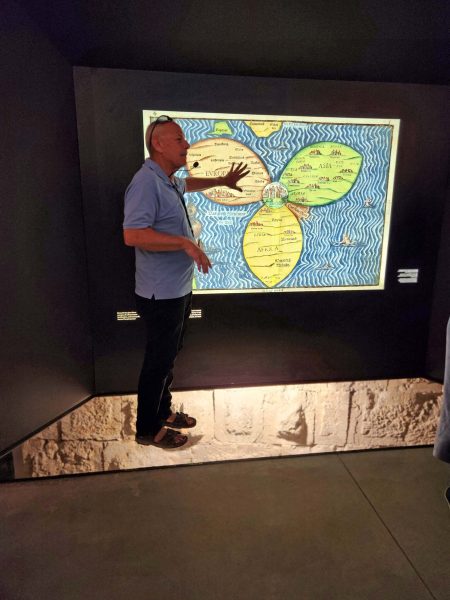
The photo below shows a screenshot of the slide show depicting the centuries of Jerusalem’s growth. The pictures changed every few seconds for about 10-15 minutes per cycle, and showed the city’s entire history of battles, buildings, growth, destruction, invasions, etc., in a unique and fascinating way.
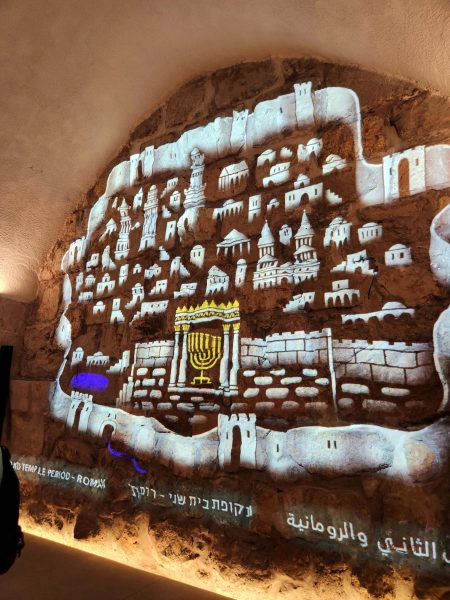
This photo shows a similar display of the development of the calendar. I’m sure it’s obvious that still photos of these light displays do not do them justice, but in person, they were excellent—clear, comprehensive, and concise. One of the posted signs included with the calendar display described a calendar as “a system that illustrates the abstract concept of time.” Wow! A calendar seems concrete, so I’ve never thought of it being based on an abstraction.
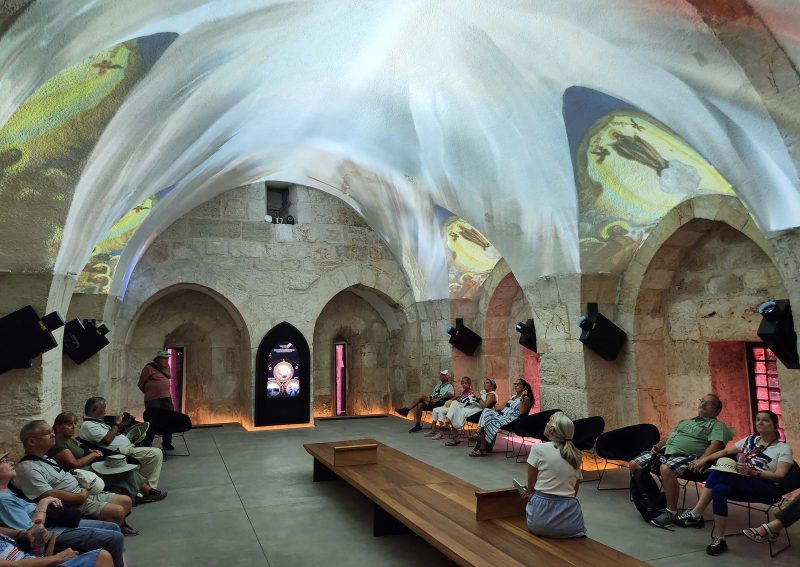
No city tour would be complete without an opportunity to buy local items and/or souvenirs. Frankly, I could live without the free time for shopping, but it’s amazing how many people look forward to that part most of all. Two ladies in our group bought several things every day. Ted and I are sure that, after 18 days of traveling, they needed at least one extra suitcase for each of them to bring all their purchased items home.
For me, the markets were an experience more than a retail thrill, and the experience was mostly related to aggressive marketing. As you approach a venue, the vendors on foot are ready for you, holding items in their hands, walking right up to you, raising their items almost to your face, and shouting “Ten dollah, ten dollah!” We were told to simply say “no thank you” and to keep walking forward. On the way out of the venue, we’d pass the vendors again and the price would have changed to “Five dollah, five dollah!” With a little bargaining, the vendors often settled for one or two dollars.
Other markets were more—shall I say “formal”?—with actual booths and tables. I liked them better. The vendors were less aggressive unless you showed interest in one of their items. In that case, it was difficult to politely excuse yourself. Amir gave us a code to help us decide how much to pay for items. He gives tours every day, and he sees these vendors every day, so he doesn’t want to offend them. According to the code, if we questioned a price and Amir replied, “It’s very good,” that meant it was much too high. If he replied, “That’s an excellent price,” it meant the price was fair. One thing all the markets had in common was bright colors.
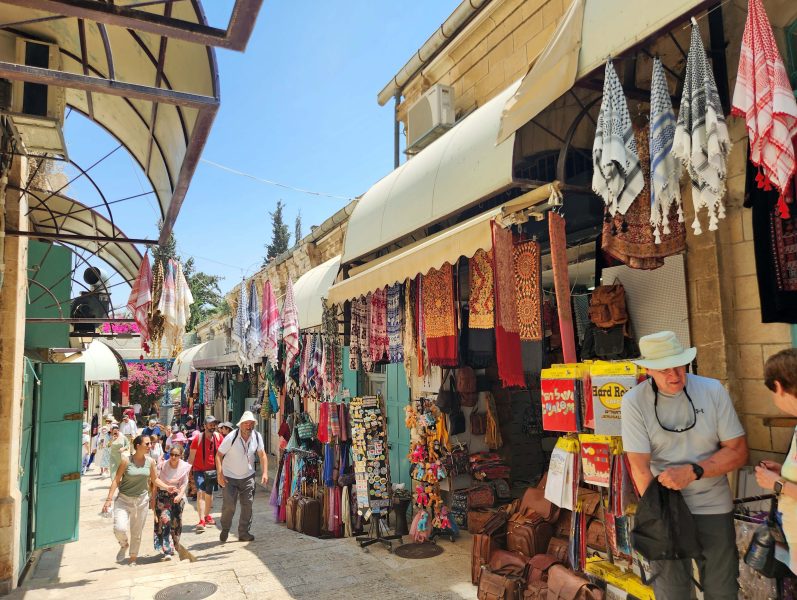
After an interesting but hot eight hours outdoors, we were all ready to get back to our air-conditioned hotel, get off our feet for a while, and start thinking about dinner. Today was a good start to Ted’s and my BT.